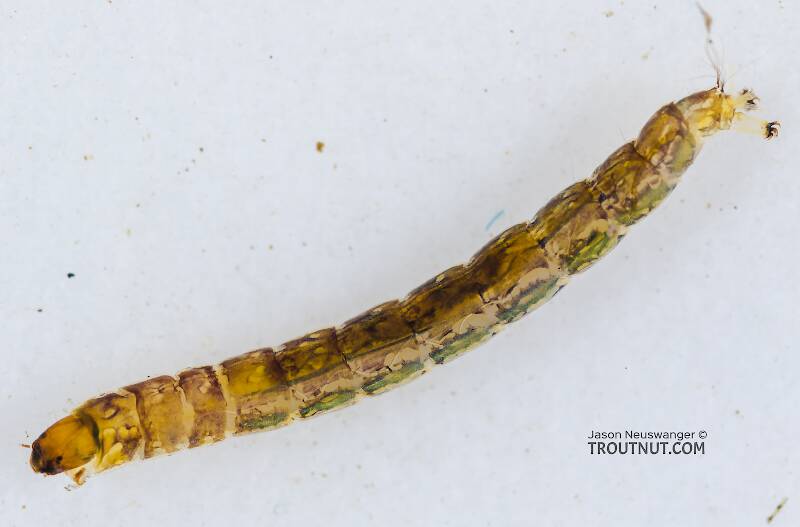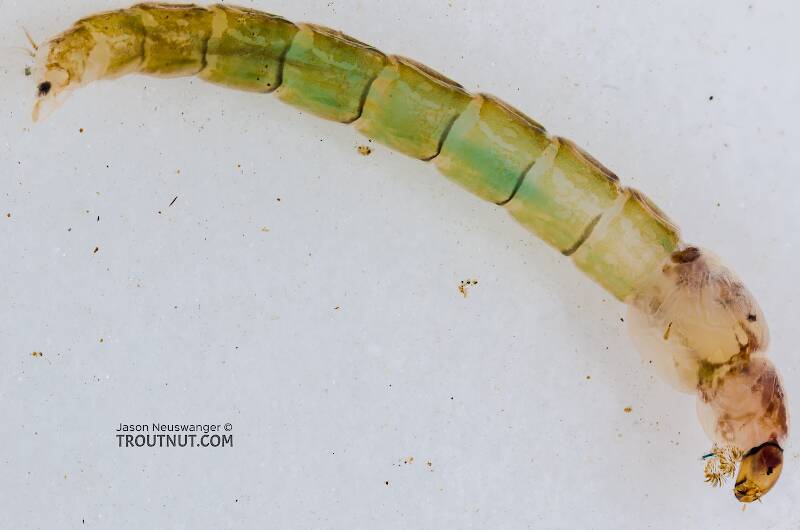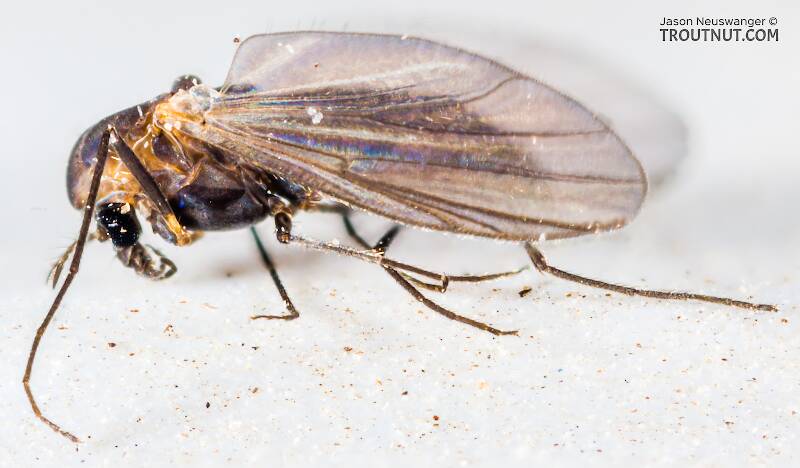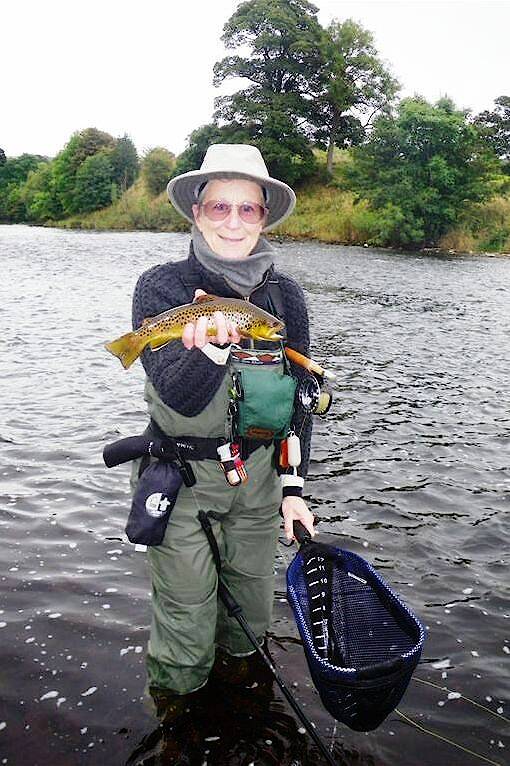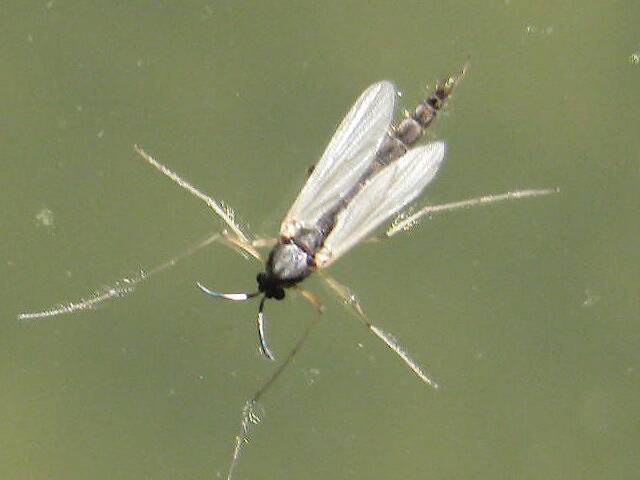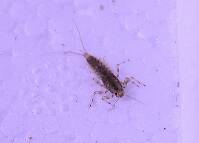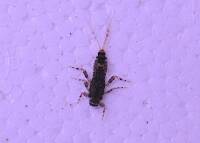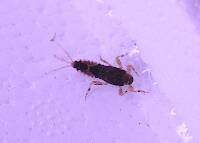
Salmonflies
Pteronarcys californica
The giant Salmonflies of the Western mountains are legendary for their proclivity to elicit consistent dry-fly action and ferocious strikes.
Featured on the forum

This dun emerged from a mature nymph on my desk. Unfortunately its wings didn't perfectly dry out.

Troutnut is a project started in 2003 by salmonid ecologist Jason "Troutnut" Neuswanger to help anglers and
fly tyers unabashedly embrace the entomological side of the sport. Learn more about Troutnut or
support the project for an enhanced experience here.
This topic is about the True Fly Family Chironomidae
Midges are the most important aquatic insects in some places, especially fertile spring creeks where they are extremely abundant and the current is so slow that it's efficient for trout to surface feed on very tiny insects.Some midges are large, up to hook size 14, but the majority are size 22 or smaller. The number of genera and species is hopelessly huge for angler entomologists to ever learn, and the identifing characteristics often require slide-mounting tiny parts under high-powered microscopes. Even the most Latin-minded fisherman must slip back to the basics--size and color--to describe his local midge hatches.
Example specimens
CaseyP on Dec 8, 2007December 8th, 2007, 1:44 pm EST
says here midge pupae rise in the water and struggle in the film to become adults. my imitations are so small that they don't seem to go down very far in order to rise--ike a wet fly might at the end of the swing. any ideas? or am i fishing them wrong?
"You can observe a lot by watching." Yogi Berra
LittleJ on Dec 8, 2007December 8th, 2007, 3:02 pm EST
I usually fish midges like I would any nymph with weight and an indicator. A little off topic, but I fish midges on the surface with an indicator as well usually trailing a wulff or something i don't need a 10x spotting scope to see.
Jeff
Jeff
SlateDrake9 on Dec 10, 2007December 10th, 2007, 11:49 am EST
Beads. Tungstun beads.
Fishing with bait is like swearing in church.
-- Slate Drake
-- Slate Drake
CaseyP on Dec 10, 2007December 10th, 2007, 1:24 pm EST
oh, of course! instead of the glass beads. or maybe both...the glass kind looks rather like eyes, or something living anyway. thanks for the help, guys!
"You can observe a lot by watching." Yogi Berra
Jmd123 on Dec 13, 2007December 13th, 2007, 7:45 am EST
I can confirm the difficult taxonomy of midges (Chironomidae). I almost got a PhD in aquatic enotmology - I was enrolled at U of Missouri in the late 90's. I didn't finish the degree - otherwise I could be known as Dr. DeNike - but I did a lot of midge taxonomy, somewhere in the order of 700-800 specimens. The taxonomy is based upon the structures of the head, particularily antennae and mouthparts. This required mounting on microscope slides and smashing the head just enough to spread out the mouthparts for easy visibility. If you didn't smash hard enough you couldn't see anything as the head is rather opaque, and if you smashed too hard the whole thing would explode and you would have to go searching around the slide for the parts you need to see. This was just to take them to genus! I ended up doing about 250 more in my first consulting job too...
My best FISHING experiences with Chironomidae were in the pond I lived on while in that PhD program. Big (size 14-16), plume-antennaed males of perhaps a Chironomus species (plumosus?) would skim the water's surface about dusk and get snapped up by big (6-10") bluegills (and one 12 1/2" black crappie one night, much to my surprise). An Adams or Mosquito in the appropriate sizes were the ticket there.
Jonathon
My best FISHING experiences with Chironomidae were in the pond I lived on while in that PhD program. Big (size 14-16), plume-antennaed males of perhaps a Chironomus species (plumosus?) would skim the water's surface about dusk and get snapped up by big (6-10") bluegills (and one 12 1/2" black crappie one night, much to my surprise). An Adams or Mosquito in the appropriate sizes were the ticket there.
Jonathon
No matter how big the one you just caught is, there's always a bigger one out there somewhere...
Iso18
Posts: 2
Posts: 2
Iso18 on Jul 29, 2009July 29th, 2009, 5:48 pm EDT
my favorite family river is known for its fantastic midge fishing.Size 28-32 is the norm.A simple cdc wing and thread for dries and a cdc tail and over wing for the pupae work wonders,One of my guide friends pulls them out one after the other with great abandon.I am getting to be in the ballpark with him,at least on the bench,waiting to pinch hit and this style of fishing has opened up many doors to my fly fishing success.I have doubled the trout i take now,Currently the smallest fly i have caught a trout on is a 28,,,157 in 7 trips this year alone,over half being caught on # 26-28 flies.I am now cranking out 30's and getting even closer to becoming a midgeaholic,
shane
shane
Falsifly on Jul 30, 2009July 30th, 2009, 6:25 am EDT
Casey, I don’t think you are doing anything wrong. Once the successful imitative pattern has been determined I tie without weight. I find non weighted flies more versatile, preferring to weight my leader to get the fly down when the fish are feeding at or near the bottom. Once the emergence begins the fish may feed at any level in the water column, so the weight is removed. If feeding very near or in the surface film I will apply floatant to the leader and tippet up to the fly as needed. Normally when the fish start feeding at various levels of the water column, keying in on a particular depth is unnecessary. However, fishing still water is another story. In this case the actual ascension of the fly in the water column is unmasked; do to the lack of current, which may very well prove the trigger to the strike. Techniques are necessary to get the fly down and rise during the retrieve, and this can prove very difficult because surface tension plays havoc when trying to get very small flies to sink.
Falsifly
When asked what I just caught that monster on I showed him. He put on his magnifiers and said, "I can't believe they can see that."
When asked what I just caught that monster on I showed him. He put on his magnifiers and said, "I can't believe they can see that."
Softhackle on Jul 31, 2009July 31st, 2009, 2:37 am EDT
Hi Casey,
First, I'm speaking from the view of a wet-fly fisherman that uses mostly wingless wets, as you know. I base my fishing on a lot of tried and true wet fly techniques, and I don't particularly like to weight flies, nor do I like putting weight on the leader. I believe these added weights may impede their natural action in the water. The first by making it act more like a weight than a very light natural fly at the mercy of the currents and the second by interfering with action and the transmission of movement imparted by the angler.
Besides, how does one weight a very delicately tied soft hackle? Again, how does one get the same fly to sink deeply?
Casting further upstream helps to give the fly time to sink is one way, but not always successful using small flies. Before all this floating fly craze came onto the scene, fishers used silk lines that undoubtedly sank because they took on water, taking the flies down with it. Today because we often concentrate more on surface fishing, we tend to forget that sink tip and full sinking lines are available in the correct weight for the rods we use. Using a fly on a sink tip or sinking line will not impair the action of the fly subsurface nor impede imparted action by the angler, but afford the weight needed to get the fly deeper.
I carry a full sinking line with me on an extra spool. That way, when I need the fly to sink, it takes me but a few minutes to change out my floating line to a sinking one. For shallow water like we have when midges are about, a sink tip would work fine.
Just my two cents,
Mark
First, I'm speaking from the view of a wet-fly fisherman that uses mostly wingless wets, as you know. I base my fishing on a lot of tried and true wet fly techniques, and I don't particularly like to weight flies, nor do I like putting weight on the leader. I believe these added weights may impede their natural action in the water. The first by making it act more like a weight than a very light natural fly at the mercy of the currents and the second by interfering with action and the transmission of movement imparted by the angler.
Besides, how does one weight a very delicately tied soft hackle? Again, how does one get the same fly to sink deeply?
Casting further upstream helps to give the fly time to sink is one way, but not always successful using small flies. Before all this floating fly craze came onto the scene, fishers used silk lines that undoubtedly sank because they took on water, taking the flies down with it. Today because we often concentrate more on surface fishing, we tend to forget that sink tip and full sinking lines are available in the correct weight for the rods we use. Using a fly on a sink tip or sinking line will not impair the action of the fly subsurface nor impede imparted action by the angler, but afford the weight needed to get the fly deeper.
I carry a full sinking line with me on an extra spool. That way, when I need the fly to sink, it takes me but a few minutes to change out my floating line to a sinking one. For shallow water like we have when midges are about, a sink tip would work fine.
Just my two cents,
Mark
"I have the highest respect for the skilled wet-fly fisherman, as he has mastered an art of very great difficulty." Edward R. Hewitt
Flymphs, Soft-hackles and Spiders: http://www.troutnut.com/libstudio/FS&S/index.html
Flymphs, Soft-hackles and Spiders: http://www.troutnut.com/libstudio/FS&S/index.html
Wbranch on Jul 31, 2009July 31st, 2009, 5:18 pm EDT
I like putting a 3/0 buck shot about 10" above my midge pupa - that really gets through the film quickly.
Catskill fly fisher for fifty-five years.
Ummm on Jan 17, 2018January 17th, 2018, 1:38 pm EST
try runnig a tandem rig (size 12) in front of the midge when the getting gets tough. if all works well it will help keep your midge down and doubles as attractant to get then looking in the right direction for that size24 midge that trails. if u add weight do it in front of the first fly to keep your midge following first fly to not loose the above effect. hope this helps. never a sure thing but i worth a shot.
Quick Reply
Related Discussions
Topic
Replies
Last Reply
2
May 17, 2018
by Subway
by Subway
5
Mar 9, 2020
by Troutnut
by Troutnut


